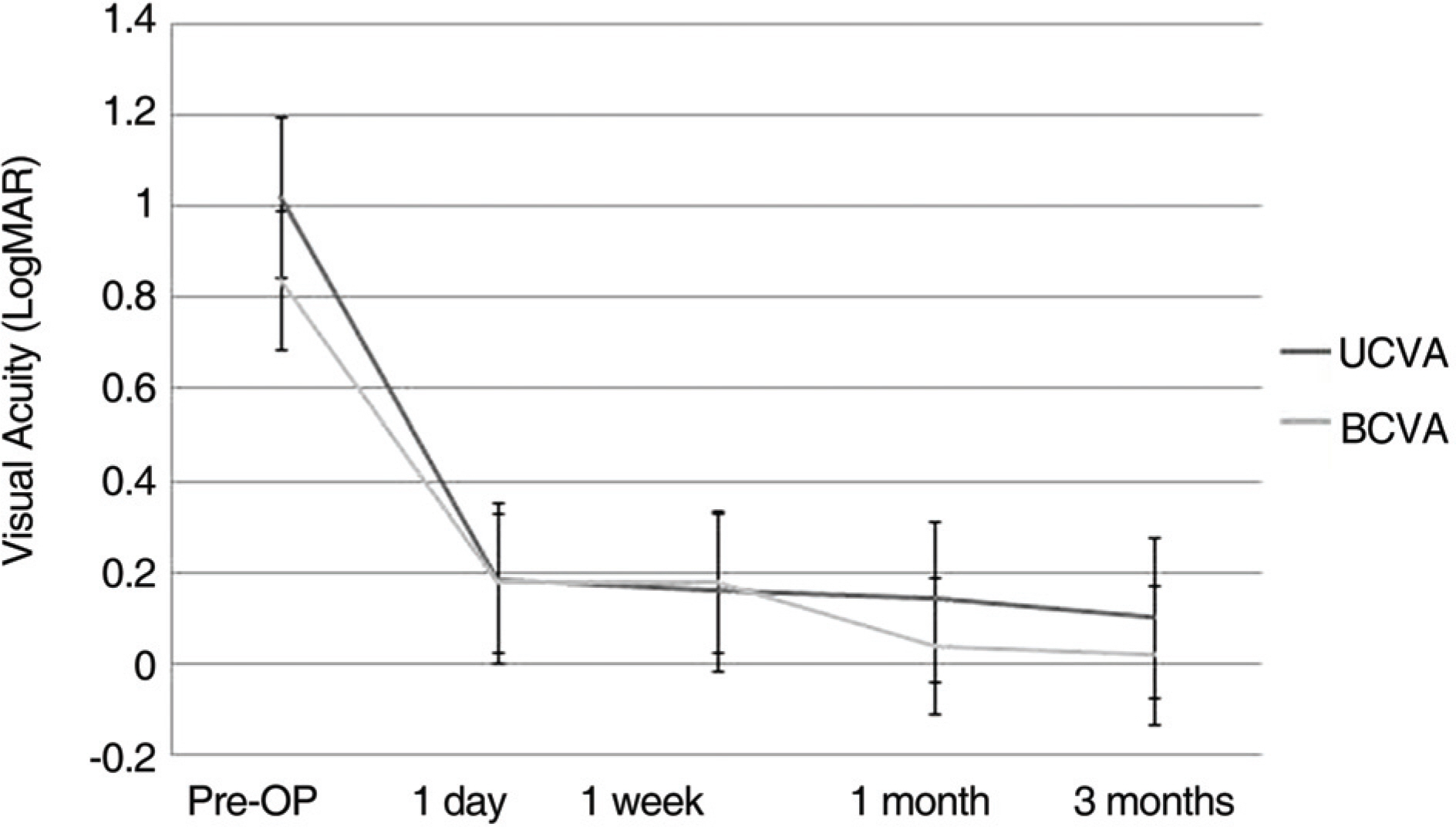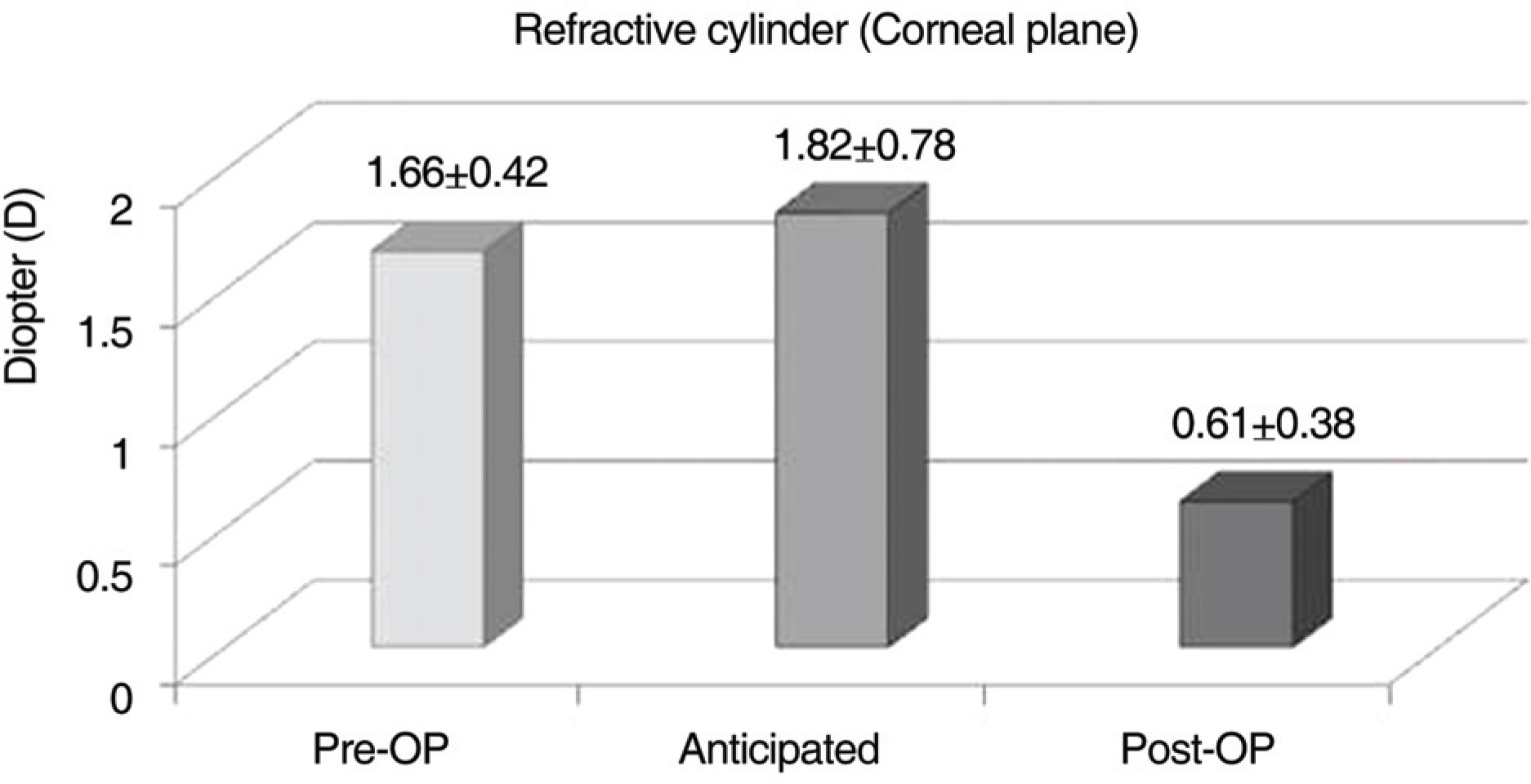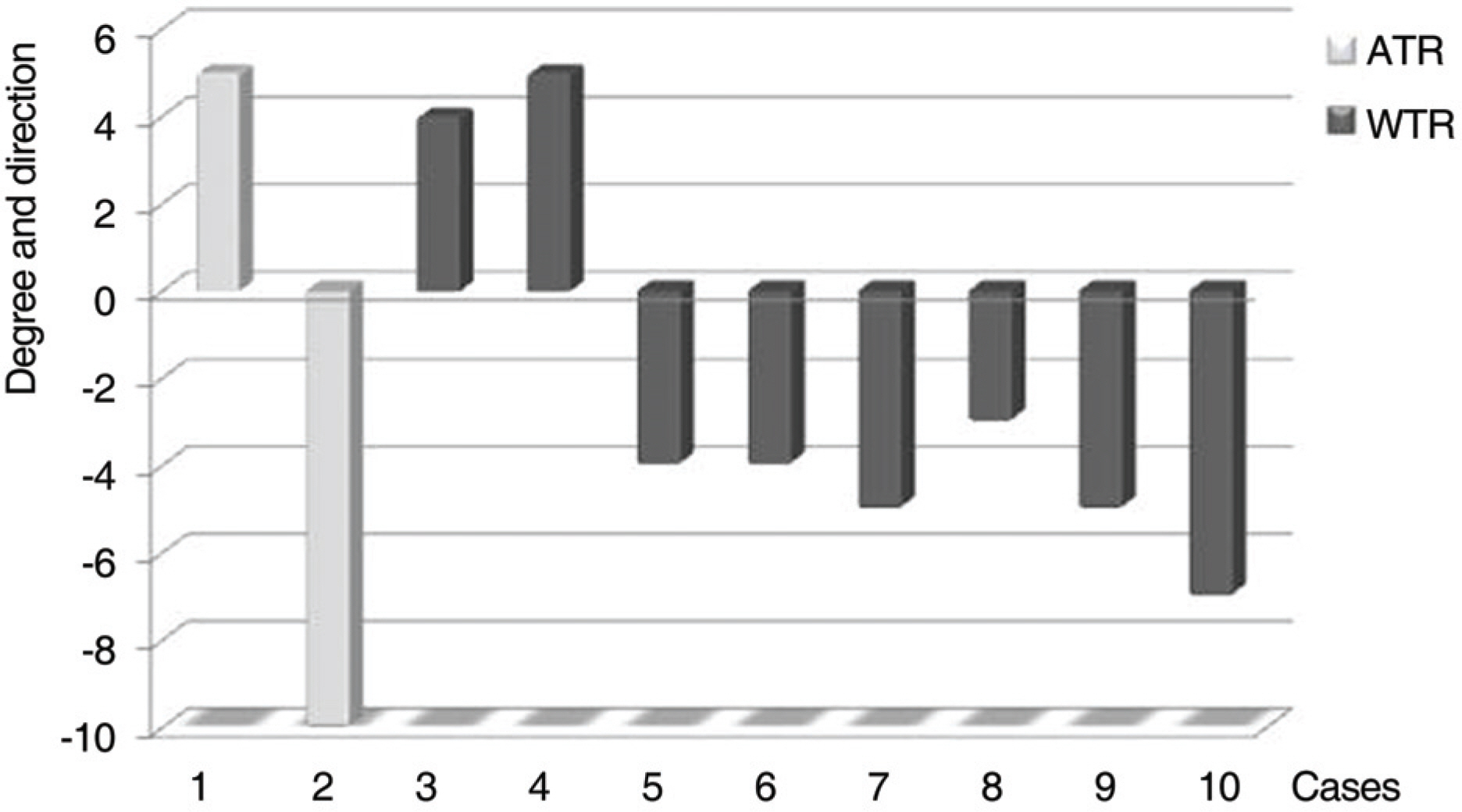The Clinical Result of AcrySof Toric Intraocular Lens Implantation
- Affiliations
-
- 1Department of Ophthalmology and Visual Science, College of Medicine, The Catholic University of Korea, Seoul, Korea. ckjoo@catholic.ac.kr
- KMID: 2212359
- DOI: http://doi.org/10.3341/jkos.2009.50.6.831
Abstract
-
PURPOSE: To evaluate the short-term efficacy of astigmatism correction and rotational stability of AcrySof Toric Intraocular lens (IOL) implants.
METHOD: We analyzed 27 eyes of 23 patients who underwent microcoaxial cataract surgery (MCCS) and AcrySof Toric IOL implantation between March 2008 and July 2008. We evaluated visual acuity, keratometry, and refraction. Slit-lamp retro-illumination photographs were obtained in all patients on 1 day, 1 month and 3 months postoperatively. The change of postoperative IOL axis alignment and the presence of anterior capsular shrinkage were analyzed.
RESULT: The mean unaided visual acuity (LogMAR) improved from 1.02+/-0.38 to 0.10+/-0.12. Although postoperative manual keratometric value was not different from the preoperative value, post-operative astigmatism decreased from a mean value of 1.66+/-0.42D to 0.61+/-0.38D at 3 months postoperatively. The mean difference between achieved and intended lens axis was 1.63+/-2.83 degrees at the first post-operative day, and 1.91+/-2.92 degrees on the first postoperative month, with all cases within 10 degrees. There were two cases of IOL rotation between one day and one month postoperative follow-up, and severe anterior capsule contractions were found in them.
CONCLUSIONS
AcrySof Toric IOL is effective for correction of astigmatism and it has good post-operative rotational stability. Because most of misalignments were found at the postoperative day 1, the precise implantation of IOL, according to the intended axis, can be important during operation and immediately after the operation.
MeSH Terms
Figure
Cited by 4 articles
-
Effects of Axial Length and Vitrectomy on Refractive Error after Cataract Surgery Using SRK/T Formula
Min Kyu Lee, Kyu Yeon Hwang, Man Soo Kim
J Korean Ophthalmol Soc. 2013;54(2):257-264. doi: 10.3341/jkos.2013.54.2.257.Analysis of Miscorrection after Implantation of the Toric Intraocular Lens
Hye Min Jeon, Kyung Heon Lee
J Korean Ophthalmol Soc. 2014;55(11):1636-1641. doi: 10.3341/jkos.2014.55.11.1636.Effect of Toric Intraocular Lens Implantation on Astigmatism in Cataract Surgery
Yong Jae Cha, Mee Kum Kim, Won Ryang Wee
J Korean Ophthalmol Soc. 2015;56(10):1544-1551. doi: 10.3341/jkos.2015.56.10.1544.Comparison of the Clinical Outcomes of Two Types of Toric Intraocular Lens
Soon Won Yang, Jae Hoon Lee, Sung A Lim, So Hyang Chung
J Korean Ophthalmol Soc. 2016;57(2):200-207. doi: 10.3341/jkos.2016.57.2.200.
Reference
-
References
1. Hoffer KJ. Biometry of 7500 cataractous eyes. Am J Ophthalmol. 1980; 90:360–8.
Article2. Colin J, Cochener B, Le Floch G. Excimer laser treatment of myopic astigmatism: a comparison of three ablation programs. Ophthalmology. 1998; 105:1182–8.3. Dausch D, Klein R, Landesz M, Schroder E. Photorefractive keratectomy to correct astigmatism. J Cataract Refract Surg. 1994; 20:S252–7.4. Salchow DJ, Zirm ME, Stieldorf C, Parisi A. Laser in situ keratomileusis for myopia and myopic astigmatism. J Cataract Refract Surg. 1998; 24:175–82.
Article5. Knorz MC, Wiesinger B, Liermann A, et al. Laser in situ keratomileusis for moderate and high myopia and myopic astigmatism. Ophthalmology. 1998; 105:932–40.
Article6. Lee KM, Kim EC, Kim MS. Excimer laser refractive surgery to correct anisometropia due to residual astigmatism after cataract surgery. J Korean Ophthalmol Soc. 2008; 49:1589–96.
Article7. Niles C, Culp B, Teal P. Excimer laser photorefractive keratectomy using an erodible mask to treat myopic astigmatism. J Cataract Refract Surg. 1996; 22:436–40.
Article8. Shimizu K, Misawa A, Suzuki Y. Toric intraocular lenses: correcting astigmatism while controlling axis shift. J Cataract Refract Surg. 1994; 20:523–6.
Article9. Werblin TP. Do three-piece PMMA IOLs rotate after implantation in the capsular bag? J Refract Surg. 1995; 11:468–71.
Article10. Grills JP, Martin RG, Sanders DR. Sutureless Cataract Surgery: An Evolution Toward Minimally Invasive Technique. Thorofare, NJ: Slack Inc;1992. p. 183–97.11. Gills JP, Martin RG, Thornton SP, Sanders DR. Surgical Treatment of Astigmatism. Thorofare, NJ: Slack Inc;1994. p. 159–64.12. Mendicute J, Irigoyen C, Aramberri J, et al. Foldable toric intraocular lens for astigmatism correction in cataract patients. J Cataract Refract Surg. 2008; 34:601–7.
Article13. Cravy TB. Calculation of the change in corneal astigmatism following cataract extraction. Ophthalmic Surg. 1979; 10:38–49.14. Horn JD. Status of toric intraocular lenses. Curr Opin Ophthalmol. 2007; 18:58–61.
Article15. Novis C. Astigmatism and toric intraocular lenses. Curr Opin Ophthalmol. 2000; 11:47–50.
Article16. Weinand F, Jung A, Stein A, et al. Rotational stability of a single-piece hydrophobic acrylic intraocular lens: new method for high-precision rotation control. J Cataract Refract Surg. 2007; 33:800–3.
Article17. Sun X-Y, Vicary D, Montgomery P, et al. Toric intraocular lenses for correcting astigmatism in 130 eyes. Ophthalmology. 2000; 107:1776–82.
Article18. Till JS, Yoder PR Jr, Wilcox TK, Spielman JL. Toric intraocular lens implantation: 100 consecutive cases. J Cataract Refract Surg. 2002; 28:295–301.
Article19. Zuberbuhler B, Signer T, Gale R, Haefliger E. Rotational stability of the AcrySof SA60TT toric intraocular lenses: A cohort study. BMC Ophthalmology. 2008; 8:1471–2415.
Article20. Bauer NJC, Vries NE, Webers CA, et al. Astigmatism management in cataract surgery with the AcySof toric intraocular lens. J Cataract Refract Surg. 2008; 34:1483–8.
- Full Text Links
- Actions
-
Cited
- CITED
-
- Close
- Share
- Similar articles
-
- The Efficacy of KR-1W Aberrometer in Assessing the Astigmatism after Toric Intraocular Lens Implantation
- Scleral Fixation of a Single-Piece AcrySof Toric Intraocular Lens: A Case Report
- Rotational Stability of AcrySof Toric Intraocular Lens Over Time: Influence of Capsulorhexis Contraction
- Long-Term Efficacy and Rotational Stability of AcrySof Toric Intraocular Lens Implantation in Cataract Surgery
- Analysis of Miscorrection after Implantation of the Toric Intraocular Lens





